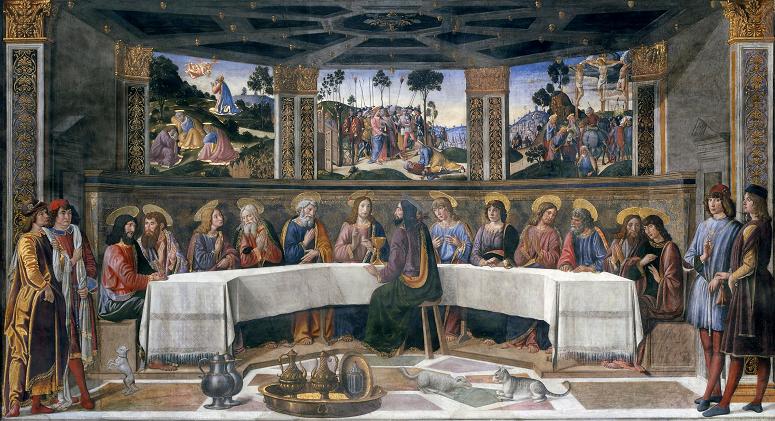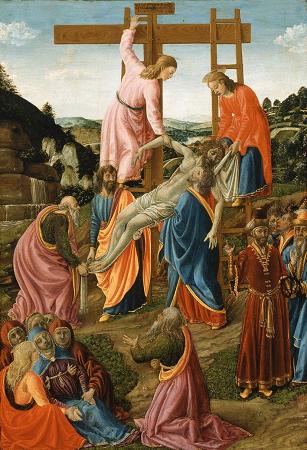Cosimo Rosselli (1439 - 1507). Cosimo Rosselli was an Italian painter of the Quattrocento, active mainly in his birthplace of Florence, but also Lucca earlier in his career, and from 1480 in the Sistine Chapel in Rome, where he painted some of the large fresco panels on the side walls. Despite being roughly the same age as Sandro Botticelli, Pietro Perugino and Domenico Ghirlandaio, the other leading Florentine painters, all regarded as greater talents, Rosselli was still able to win several large commissions, which is a testament to the high level of activity in the city. He painted almost entirely religious subjects, with a few portraits. He did other large frescos with his workship, from which Fra Bartolomeo and Piero di Cosimo, who married Roselli's daughter, were his most famous pupils. These include a chapel in Sant'Ambrogio, Florence and one of the large spaces in the cloister of Santissima Annunziata, Florence. Cosimo was born in Florence. In 1460, at the age of fourteen, he became a pupil of Neri di Bicci, working as an assistant to his cousin Bernardo di Stefano Rosselli. A first youthful work of Cosimo mentioned by Giorgio Vasari is the Assumption of the Virgin altarpiece in the third chapel on the left of the nave in Sant'Ambrogio in Florence. In the same church, on the wall of one of the chapels, is a fresco by Cosimo which Vasari praises highly, especially for a portrait of the young scholar Pico of Mirandola. The scene, a procession bearing a miracle-working chalice, is painted with vigor and less mannerism than most of this artist's work. A picture painted by Rosselli for the church of the Annunziata, with figures of SS. Barbara, Matthew and the Baptist, is in the Academy of Florence. Rosselli also spent some time in Lucca, where he painted several altarpieces for various churches. A picture attributed to him, taken from the church of St. Girolamo at Fiesole, is now in the National Gallery of London. It is a large retable, with, in the center, St. Jerome in the wilderness kneeling before a crucifix, and at the sides standing figures of St. Damasus and St. Eusebius, St. Paula and St. Eustochium; below is a predella with small subjects. Though dry and hard in treatment, the figures are designed with much dignity. In 1480, Rosselli was one of the painters called by Pope Sixtus IV to work at the wall decoration of the Sistine Chapel, together with other masters including; Sandro Botticelli, Pietro Perugino and Domenico Ghirlandaio. Rosselli and his collaborators executed two or three frescoes: the Descent from Mount Sinai, the Last Supper and, perhaps, the Sermon of the Mount. The Passage of the Red Sea is variously attributed to him, to Ghirlandaio or to Biagio d'Antonio. Giorgio Vasari wrote in his Lives of the Most Excellent Painters, Sculptors, and Architects that, differently from the other painters who followed a common pattern in the size and style of the frescoes, Rosselli used brighter colors, including gold, a trick which granted him the appreciation of the Pope. The Gemeldegalerie, Berlin has three pictures by Rosselli: The Virgin in Glory, The Entombment of Christ and The Massacre of the Innocents. In 1480 Rosselli, together with the chief painters of Florence, was invited by Pope Sixtus IV to Rome to assist in the painting of the frescoes in the Sistine Chapel. Three of these were executed by him The Destruction of Pharaohs Army in the Red Sea, Christ Preaching by the Lake of Tiberias and The Last Supper. His chief pupil was Fra Bartolomeo. Among Roselli's other pupils were Angelo di Donino and Giovanni Battista Vanni. According to Vasari, Rosselli died in 1484, but this is a mistake, as he was known to have been living on 25 November 1506.
more...












